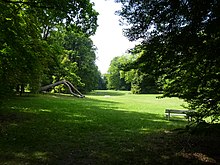Ernst Friedrich von Dörnberg
Ernst Friedrich von Dörnberg (born April 16, 1801 in Regensburg ; † November 26, 1878 there ) was head of Thurn & Taxis ' overall administration until 1871 .
Life
Ernst Friedrich was the son of the Bavarian General Commissioner Konrad Heinrich (Ernst Friedrich) von Dörnberg and the Freiin Wilhelmine Sophie von Glauburg (1775-1835). He was the brother of Wilhelmine von Dörnberg (1803-1835), who married Prince Maximilian Karl von Thurn und Taxis in 1828 , and Sophie von Dörnberg (1795-1854), who married Count von Pückler and Limpurg in 1817 . Ernst Friedrich von Dörnberg was forest manager in Hohengebraching from 1824 and from 1828 to 1871 head of Thurn & Taxis' overall administration, whose assets in shares and government securities he increased more than tenfold between 1835 and 1871. In the "Dörnberg'schen memoranda" published in 1863 on the reform of the German Confederation in the spirit of the Thurn and Taxis family, he advocated a greater German solution. He was raised to the count in Vienna on February 21, 1865. He died in Regensburg in 1878.
Aftermath
Ernst Friedrich acquired the villa in Regensburg in 1832, which was built 1804–1806 according to plans by the court architect Emanuel Herigoyen by the Jewish court banker of the Princes of Thurn and Taxis Philipp Reichenberger under the supervision of the princely building director Joseph Sorg. In 1834 Ernst Friedrich had the two side wings of the villa expanded for residential purposes for his sick sister Wilhelmine Fürstin von Thurn und Taxis and connected to the main building with corridors. This created the building of today's Dörnbergpalais . With the villa, Ernst Friedrich had also acquired the associated park, which he had expanded considerably to the size of today's Dörnbergpark . The park was transformed into an English landscape park by the royal Bavarian court gardener Carl von Effner between 1864 and 1867 . The park buildings that still exist today (Swiss house, society house, gardener's house and greenhouse) as well as the buildings that have since been abandoned (machine house, horse stable and carriage shed, bark house, pavilion) also date from this time.
Descendants and funerals
His son, Ernst Graf von Dörnberg (1836–1897) since 1879, returned to Regensburg in 1865 after military service in Austria, supported his father in the administration of the property and increased the property considerably after his father's death. He remained unmarried, lived withdrawn in the palace and after his death left the entire fortune of 17.4 million marks for social purposes. In his will it was stated “ I will use all my assets to support orphans, for scholarships and to found charitable and useful institutions ”. The park and the rest of the property is still managed by the “Gräflich von Dörnberg'schen Orphan Fund Foundation”.
For members of the von Dörnberg family who were buried in the Lazarusfriedhof, a mausoleum with extensive natural stone furnishings was built in 1911/12 on the new Evangelical Central Cemetery, which was inaugurated in 1898, according to plans by the architect German Bestelmeyer for members of the von Dörnberg family. The mausoleum closed off the cemetery built on the sloping terrain at the highest point to the south and can be seen from afar. It is characterized by a flight of stairs flanked by resting lions and a high, steep-arched stone dome clad in shell limestone, based on the Byzantine model. Above the portal the coat of arms of the von Dörnberg family. In the interior, vaulted by a flat dome painted in Art Nouveau style, is the circular crypt with eight burial chambers. The room is decorated with mosaics and a large Caritas figure, as well as a bust of the son Ernst von Dörnberg, with whom the count's Dörnberg line died out.
Individual evidence
- ↑ Hans-Michael Körner: Large Bavarian Biographical Encyclopedia , p. 382.
- ↑ Siegfried Meyer Grill: Habsburgs servants in Post and Politics: the "house" Thurn und Taxis 1745 to 1867 , P. von Zabern, of 2005.
- ^ A b Karl Bauer : Regensburg. Art, culture and everyday history (6th expanded and improved edition, pp. 595–597). Mittelbayerische Druck- und Verlags-Gesellschaft, Regensburg 2014, ISBN 978-3-86646-300-4 .
- ^ Karl Bauer: Regensburg Art, Culture and Everyday History . 6th edition. MZ-Buchverlag in H. Gietl Verlag & Publication Service GmbH, Regenstauf 2014, ISBN 978-3-86646-300-4 , p. 804-805 .
| personal data | |
|---|---|
| SURNAME | Dörnberg, Ernst Friedrich von |
| ALTERNATIVE NAMES | Dörnberg zu Herzberg, Alexander Friedrich Ernst Moritz Freiherr von (full name); Dörnberg, Ernst Friedrich Graf von (from 1865) |
| BRIEF DESCRIPTION | Head of the Thurn and Taxis administration |
| DATE OF BIRTH | April 16, 1801 |
| PLACE OF BIRTH | regensburg |
| DATE OF DEATH | November 26, 1878 |
| Place of death | regensburg |


